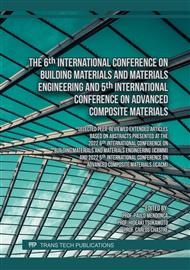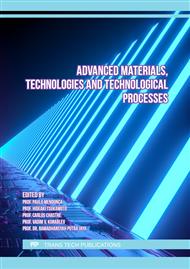[1]
C. Ortiz, «Realidad aumentada en medicina,» Revista Colombiana de Cardiología, vol. 18, nº 1, pp.4-7, 2018.
DOI: 10.1016/s0120-5633(11)70160-7
Google Scholar
[2]
K. Choi, «Virtual reality wound care training for clinical nursing education: An initial user study,» IEEE Conference on Virtual Reality and, vol. 1, nº 2019, pp.882-883, 2019.
DOI: 10.1109/vr.2019.8797741
Google Scholar
[3]
J. Henn, M. Lemole, M. Ferreira, F. González, M. Schornak, M. Preul y R. Spetzler, «Interactive stereoscopic virtual reality: a new tool for neurosurgical education,» Journal of Neurosurgery, vol. 96, nº 1, p.144–149, 2002.
DOI: 10.3171/jns.2002.96.1.0144
Google Scholar
[4]
I. Melo, «Realidad aumentada y aplicaciones,» Tecnología, Investigación y Academia, vol. 6, nº 1, pp.28-35, 2018.
Google Scholar
[5]
E. Bernita, «Estudio del uso de realidad aumentada como herramienta de apoyo para estudiantes de medicina.,» Guayaquil, Ecuador, 2018.
Google Scholar
[6]
D. Jauregui, «Aplicaciones de realidad aumentada para la práctica de los profesionales sanitarios: revisión de la literatura,» Navarra, España, 2016.
Google Scholar
[7]
C. Matthes, T. Weisske, A. Emmanouil y A. Kulik, «The Collaborative Virtual Reality Neurorobotics Lab,» IEEE Conference on Virtual Reality and 3D User Interfaces (VR), vol. 2019, nº 1, pp.3-5, 2019.
DOI: 10.1109/vr.2019.8798289
Google Scholar
[8]
G. Vásquez, «Realidad virtual y simulación en el entrenamiento de los estudiantes de medicina,» Educación Médica, vol. 11, nº 2008, pp.29-31, 2008.
DOI: 10.4321/s1575-18132008000500006
Google Scholar
[9]
R. Sedlack y J. Kolars, «Computer Simulator Training Enhances the Competency of Gastroenterology Fellows at Colonoscopy: Results of a Pilot Study,» The American Journal of Gastroenterology, vol. 99, nº 1, pp.34-37, 2003.
DOI: 10.1111/j.1572-0241.2004.04007.x
Google Scholar
[10]
P. Piromchai, A. Avery, M. Laopaiboon, G. Kennedy y S. O'Leary, «Virtual reality training for improving the skills needed for performing surgery of the ear, nose or throat (Review),» Cochrane Database of Systematic Review, vol. 2015, nº 1, pp.1-54, 2015.
DOI: 10.1002/14651858.cd010198
Google Scholar
[11]
D. Andritoi, C. Luca, R. Fuior y C. Corciova, «The Application of Virtual Reality Technology in Rehabilitation,» 11th International Symposium on Advanced Topics in Electrical Engineering, vol. 2019, nº 1, pp.1-4, 2019.
DOI: 10.1109/atee.2019.8724953
Google Scholar
[12]
S. Peasgood, «Sophic Capital,» Virtual Reality: A Virtual Goldmine for Investors, vol. 20144, nº 1, pp.1-17, 2014.
Google Scholar
[13]
A. Blázquez, «Realidad aumentada en educación,» Madrid, España, 2017.
Google Scholar
[14]
I. Bajaña, A. Zúñiga, C. Can, F. Meza y A. Puris, «La realidad aumentada en la publicidad, prospectiva para el mercado ecuatoriano,» Ciencia Unemi, vol. 10, nº 23, pp.148-157, 2017.
DOI: 10.29076/issn.2528-7737vol10iss23.2017pp148-157p
Google Scholar
[15]
R. Montero , «Realidad Virtual,» Autores científico-técnicos y académico, vol. 2015, nº 1, pp.51-59, 2015.
Google Scholar
[16]
L. Chamba y J. Aguilar, «Realidad Aumentada en un Aula de Clases Inteligente: Caso de Estudio "SaCI",» IEEE-Rita, vol. 12, nº 4, pp.165-172, 2017.
Google Scholar
[17]
A. Ochagavía, F. Baigorri, J. Mesquida, J. Ayuela, A. Ferrándiz, X. García, M. Monge, L. Mateu, C. Sabatier, F. Clau, R. Vicho, L. Zapata, J. Maynar y A. Gil, «Monitorización hemodinámica en el paciente crítico. Recomendaciones del Grupo de Trabajo de Cuidados Intensivos Cardiológicos y RCP de la Sociedad Española de Medicina Intensiva, Crítica y Unidades Coronarias,» Medicina Intensiva, vol. 38, nº 3, pp.154-169, 2014.
DOI: 10.1016/j.medin.2013.10.006
Google Scholar
[18]
A. Cerón y P. Bedoya, «Manual Básico de Unity 3D como apoyo al desarrollo turístico nacional Proyecto Alejandro Cerón Cardona,» Pereira, Colombia, 2014.
Google Scholar
[19]
E. Vegas, «Vuforia: Realidad aumentada para smartphones (unity 3d),» 2012. [En línea]. Available: https://emiliusvgs.com/vuforia-realidad-aumentada-para-smartphones-unity3d/.
DOI: 10.26621/xv19.2018.12.a08.pucesi.2550.6684
Google Scholar
[20]
Unity 3D, «Unity documentation,» 2018. [En línea]. Available: https://docs.unity3d.com/es/2018.4/Manual/UnityManual.html.
Google Scholar
[21]
Solidworks, «3D experience,» 2021. [En línea]. Available: https://www.solidworks.com/es.
Google Scholar
[22]
Plusesmas, «¿Qué es y cómo funciona Google SketchUp?,» 2021. [En línea]. Available: https://www.plusesmas.com/nuevas_tecnologias/articulos/internet_email/que_es_y_como_funciona_google_sketchup/165.html.
DOI: 10.15332/dt.inv.2020.02627
Google Scholar
[23]
J. Maturana, «HTC Vive, análisis: esto sí que es realidad virtual interactiva,» 2017. [En línea]. Available: https://www.xataka.com/analisis/htc-vive-analisis-esto-si-que-es-realidad-virtual-interactiva.
Google Scholar
[24]
S. Toro, «Neurociencias y aprendizaje,» Estudios Pedagógicos XXXVI, vol. 1, nº 2, pp.313-331, 2010.
Google Scholar
[25]
HTC, «Vive,» 2021. [En línea]. Available: https://business.vive.com/mx/.
Google Scholar



